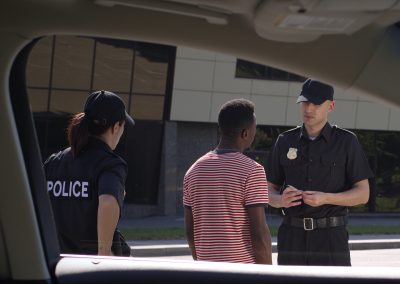“To prepare for what will happen, look to what has happened.”
Gordon Graham
History’s Lessons
The primary circumstances in which criminals take on officers in gunfights have varied little throughout history. An early example of a police officer being killed in the line of duty was recorded in New York City in 1854. During the incident, a baker interrupted two “juvenile delinquents” burglarizing his establishment. The official report said, “The rogues escaped and were closely pursued by Patrolman Cahill. He immediately closed in with the rascals and a struggled ensued. Several pistol shots were discharged. The officer gave a groan and sank to the ground and expired a few minutes later.”
According to the Officer Down Memorial Page the first police officer killed in the United States was Constable Darius Quimby of the Albany County Constable’s Office on January 3, 1791. He was shot and killed while attempting to arrest a man on a simple trespassing warrant. The suspect was hanged a little more than seven months later.
Other reports found in musty volumes document officers being killed by fugitives, liquor store robbers, rapists, “a mad man,” and in the act of “quelling a disturbance.” These killings generally occurred by pistol. Pistols continue to be predominant murder weapons, even though pistol technology has changed since they were called “horse pistols.” Then, as now, most killings took place within close distances.
Today’s Risks
Today, throughout the nation, officers continue to be killed in bars, stores, and homes, on sidewalks and highways, in alleys and gutters, predominantly by guns. More than 70 percent of the time, the fatal confrontations erupt during so-called “routine patrol duties” and especially when officers are:
- Attempting arrests.
- Responding to domestic disturbances.
- Investigating robberies-in-progress.
- Conducting traffic stops and pursuits.
Unfortunately, no assignment can be considered safe. Nor can any time, day, month, or location. Officers are killed in broad daylight and at night. They die on weekends and weekdays. They fall on sun-warmed sidewalks and snow-covered highways. They perish inside police stations, jails, and judges’ chambers. They have been attacked on the porches of their own homes, as well in the heart of poor urban neighborhoods. One in nine of those who die is off-duty at the time they are attacked.
Officer Charles Hartfield
This was true in the case of Las Vegas Officer Charleston “Chuckiehart,” Hartfield, who was off-duty, enjoying a country music festival, when 64-year-old Stephen Paddock of Mesquite, Nevada, began firing into a crowd of 22,000 in October of 2017 from the 32nd floor of the Mandalay Bay hotel. The officer saw the panic created by the gunfire and instead of saving himself, which he could easily have done, he turned his efforts toward assisting and protecting others. He died during those efforts, a victim of the gunfire he was saving others from.
Tactical Errors
What is also clear is that officers are making many of the same tactical errors in armed confrontations that they made in the 1700s. After more than 200 years of consistency in the circumstances and outcomes of officer-involved shootings, many departments are beginning to recognize the core problem—there is a large gap between the amount of training most officers receive and the amount of training they actually need to meet the challenges they confront on the job.
In recent years, trainers all over the nation have tried to close this gap, especially in the important area of firearms combat. In the past, initial recruit, range training, and subsequent qualification requirements focused on shooting stationary targets at a distance of 21 to 150 feet. The action was slow and deliberate. The range-master shouted in a measured cadence, “Ready on the right! Ready on the left! Ready on the firing line. Fire!”
This dry and predictable range protocol has since been abandoned by many departments and replaced by a more dynamic and realistic approach that prepares officers to win gunfights rather than trophy shoots.
Why Not Train?
Many reasons are given for not training sufficiently. The most common are that budgets and manpower shortages do not allow for time intensive, dynamic, stress induced, decision-making survival training. The excuses roll off the tongues of administrators naturally as if the explanations are in anyway reasonable or acceptable. One officer was asked why he was attending a “train the trainer” course on his own time. He said he planned on becoming a trainer so that he could pressure his boss to offer training more often. He explained that his department begrudgingly trained once a year in firearms, but had not practiced defensive tactics for eight years. This is not only unacceptable, but it is exactly what the U. S. Supreme Court is talking about when they use the term “deliberate indifference.”
Calibre Press did a survey in 2016 about how often agencies train on the range in the areas of defensive/control tactics and stress-filled dynamic scenarios training. We had thousands of responses from a multitude of officers and departments. The results were as eye-opening as they were disheartening.
Contrary to what is propagated in the media, law enforcement actually does very little defensive tactics, less-lethal, firearms and dynamic-scenario force-training.
- Over sixty percent of respondents are required to shoot on the range only once or twice yearly.
- Only one percent are required to qualify with a sidearm monthly.
- A full quarter (twenty-five percent) NEVER train on dynamic ‘shoot/don’t shoot’ (FATS, Simunitions, Airsoft, etc.) scenario-type training!
- Forty-two percent never do any kind of defensive tactics training!
- When it comes to less-than-lethal training, fifty-five percent do it yearly, while a full thirty percent do it less than that or never.










0 Comments